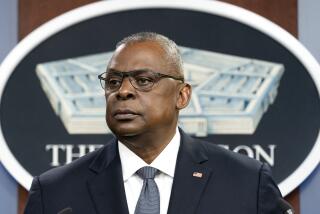Bid to Save C-17 Line Gets Another Boost
- Share via
Boeing Co.’s campaign to keep open the C-17 production line in Long Beach got another shot in the arm Monday as an influential Pentagon panel called for buying more of the military cargo planes.
In a 163-page report that examined the military’s mobility needs, the Defense Science Board said the Air Force must have the option to buy more C-17s if the Pentagon wanted to meet its increased global requirements. It did not specify the number of planes needed.
More C-17s are needed as insurance for “potentially urgent but unforeseeable requirements,” the report said, adding that the planned C-17 fleet may be insufficient if the U.S. military were to face missions similar to those at the start of the Iraq war.
The panel’s recommendation was disclosed just days after the Senate voted 89 to 8 for an amendment to the defense spending bill calling for the Air Force to acquire 42 C-17s beyond the 180 delivered or on order. The amendment is not binding, but it marked the first step in a concerted effort by Congress to keep the Long Beach plant running until 2012.
The Air Force last month scrapped plans to order more of the planes, citing budget constraints. If approved by Defense Secretary Donald H. Rumsfeld, the decision would force Boeing to close the state’s last major airplane manufacturing plant in 2008 and lay off most of its 6,500 workers. Boeing has built 145 of the $175-million aircraft, nicknamed the Globemaster III.
The latest report, completed Oct. 21 but not released until Monday, “builds the case for giving the Air Force more money to buy more C-17s,” said Loren Thompson, defense policy analyst for the Lexington Institute in Arlington, Va.
The Defense Science Board “is the most prestigious group of outside experts advising the Pentagon, so saying there is a need for more C-17s has real policy consequences,” he said.
The board, composed of scientists and retired military officials, pointed to the March 2003 airdrop of 1,000 paratroopers and the delivery of their equipment and supplies into northern Iraq. That mission took 32 C-17s, or 40% of the fleet at the time, 20 days to accomplish.
But the airdrop involved only one Army battalion. Transporting a larger force would require as many as 96 aircraft for five days, or more than half the planned fleet of 180, the board said in its study.
The C-17 fleet could be required to conduct even larger airdrops while reinforcing ground units and moving supplies from the U.S. directly into combat zones, the study said.
The report’s findings bolster a campaign that includes Gov. Arnold Schwarzenegger, who last week weighed in with a letter to President Bush, urging the White House to approve buying more C-17s.
*
Bloomberg News was used in compiling this report.
More to Read
Inside the business of entertainment
The Wide Shot brings you news, analysis and insights on everything from streaming wars to production — and what it all means for the future.
You may occasionally receive promotional content from the Los Angeles Times.










